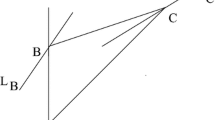Abstract
The famous conjecture of V. Ya. Ivrii (1978) says that in every billiard with infinitely-smooth boundary in a Euclidean space the set of periodic orbits has measure zero. In the present paper, we study the complex version of Ivrii’s conjecture for odd-periodic orbits in planar billiards, with reflections from complex analytic curves. We prove positive answer in the following cases: (1) triangular orbits; (2) odd-periodic orbits in the case, when the mirrors are algebraic curves avoiding two special points at infinity, the so-called isotropic points. We provide immediate applications to k-reflective real analytic pseudo-billiards with odd k, the real piecewise-algebraic Ivrii’s conjecture and its analogue in the invisibility theory: Plakhov’s invisibility conjecture.





Similar content being viewed by others
Notes
By irreducible complex analytic curve in a complex manifold we mean an analytic curve holomorphically parameterized by a connected Riemann surface.
Everywhere in the paper by cusp, we mean the singularity of an arbitrary irreducible singular germ of analytic curve, not necessarily the one given by equation \(x^{2}=y^{3}+\dots \) in appropriate coordinates.
Recall that a meromorphic mapping M → N between complex manifolds is a mapping holomorphic on the complement of an analytic subset in M such that the closure of its graph is an analytic subset in M×N. A mapping is bimeromorphic, if it is meromorphic together with its inverse.
References
Aleksenko A, Plakhov A. Bodies of zero resistance and bodies invisible in one direction. Nonlinearity. 2009;22:1247–58.
Baryshnikov Y, Zharnitsky V. Billiards and nonholonomic distributions. J Math Sci. 2005;128:2706–2710.
Glutsyuk A. On quadrilateral orbits in complex algebraic planar billiards. Mosc Math J. 2014;14(2):239–289.
Glutsyuk A. On 4-reflective complex analytic planar billiards. Preprint. http://arxiv.org/abs/1405.5990.
Glutsyuk AA, Kudryashov Yu. G. On quadrilateral orbits in planar billiards. Dokl Math. 2011;83(3):371–373.
Glutsyuk AA, Kudryashov Yu. G. No planar billiard possesses an open set of quadrilateral trajectories. J Mod Dyn. 2012;6(3):287–326.
Ivrii VYa. The second term of the spectral asymptotics for a laplace-beltrami operator on manifolds with boundary. Funct Anal Appl. 1980;14(2):98–106.
Plakhov A. Exterior billiards. Systems with impacts outside bounded domains. New York: Springer;2012.
Plakhov A, Roshchina V. Invisibility in billiards. Nonlinearity. 2011;24:847–854.
Plakhov A, Roshchina V. Fractal bodies invisible in 2 and 3 directions. Discr Contin Dyn Syst. 2013;33(4):1615–1631.
Rychlik M.R. Periodic points of the billiard ball map in a convex domain. J Diff Geom. 1989;30:191–205.
de Saint-Gervais H.P. Uniformisation des surfaces de Riemann. Retour sur un théorème centenaire, ENS Éditions, Lyon, 2010.
Stojanov L. Note on the periodic points of the billiard. J Differ Geom. 1991;34:835–837.
Tabachnikov S. Geometry and billiards. Am Math Soc., 2005.
Vasiliev D. Two-term asymptotics of the spectrum of a boundary value problem in interior reflection of general form. Funct Anal Appl. 1984;18:267–277.
Vorobets YaB. On the measure of the set of periodic points of a billiard. Math Notes. 1994;55(5):455–460.
Weyl H. Über die asymptotische verteilung der eigenwerte, nachrichten von der gesellschaft der wissenschaften zu Göttingen,. Math-Phys Klasse. 1911:110–117.
Wojtkowski MP. Two applications of Jacobi fields to the billiard ball problem. J Differ Geom. 1994;40(1):155–164.
Acknowledgments
I am grateful to Yu. S. Ilyashenko, Yu. G. Kudryashov, and A. Yu. Plakhov for attracting my attention to Ivrii’s conjecture and invisibility and for helpful discussions.
Author information
Authors and Affiliations
Corresponding author
Additional information
Supported by part by RFBR grants 10-01-00739-a, 13-01-00969-a, NTsNIL_a (RFBR-CNRS) grant 10-01-93115 and by ANR grants ANR-08-JCJC-0130-01, ANR-13-JS01-0010.
Rights and permissions
About this article
Cite this article
Glutsyuk, A. On Odd-periodic Orbits in Complex Planar Billiards. J Dyn Control Syst 20, 293–306 (2014). https://doi.org/10.1007/s10883-014-9236-5
Received:
Published:
Issue Date:
DOI: https://doi.org/10.1007/s10883-014-9236-5
Keywords
- Real (complex) planar analytic billiard
- Periodic orbit
- Complex Euclidean metric
- Isotropic lines
- Complex reflections
- Real planar analytic pseudo-billiard
- Invisibility



